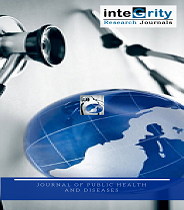
JOURNAL OF PUBLIC HEALTH AND DISEASES
Integrity Research Journals
ISSN: 2705-2214
Model: Open Access/Peer Reviewed
DOI: 10.31248/JPHD
Start Year: 2018
Email: jphd@integrityresjournals.org
Knowledge and misconceptions on cervical cancer and its prevention among female undergraduates in Sa’adu Zungur University, Bauchi State, Nigeria
https://doi.org/10.31248/JPHD2024.142 | Article Number: 28A60DFD2 | Vol.7 (1) - February 2025
Received Date: 26 November 2024 | Accepted Date: 10 February 2025 | Published Date: 28 February 2025
Authors: Abdulbaqi Alhaji Magaji , Ibrahim Musa Moi , Yahaya Mohammed Katagum , Shuaibu Suleiman , Rashidat Oluwabukola Owolabi , Nurudeen Aliyu , Ibrahim Umar Aliyu , Oladele Hanafi , Maryam Dahiru Umar and Abuhuraira Ado Musa*
Keywords: Cervical cancer, female, prevention, Bauchi State
Cervical cancer is a significant public health concern, particularly among young women. The study aims to assess the level of knowledge and misconceptions about cervical cancer and its prevention among female undergraduate students of Sa'adu Zungur University Bauchi. A descriptive cross-sectional design was adopted. The study targeted 103 participants from the total population using a standard for calculating the sample size. A structured questionnaire was used for data collection. The study observed that the majority of the respondents 49 (47.6 %) had heard about cervical cancer, 51 (49.5%) did not know that cervical cancer is preventable, 42 (40.8%) did not know that the HPV vaccine can prevent cervical cancer, 48 (46.6%) did not know that safe sex practice can prevent cervical cancer. The study highlights the need for targeted intervention to improve cervical cancer prevention among female undergraduate students of Sa’adu Zungur University. Despite some little knowledge about cervical cancer, there are significant gaps in awareness about its cause, screening and vaccination. The findings suggested that education and awareness campaigns, access to free or low-cost screening and vaccination, and addressing cultural and social barriers are crucial to improving cervical cancer prevention. This study provides valuable insight into cervical cancer prevention strategies among female undergraduate students of Sa’adu Zungur University Bauchi State. The university management should put the recommendation made in practice within both campuses. Finally, to address cultural and social barriers to cervical cancer prevention, promote awareness campaigns and encourage interdisciplinary collaboration to develop comprehensive cervical cancer prevention strategies.
| Akinkugbe, O. O., Lucas, A. O., Onyemelukwe, G. C., Yahaya, H., & Saka, M. J. (2010). Non-Communicable Diseases in Nigeria: The Coming Epidermic Nigerian Health Review. Health Reform Foundation of Nigeria (HERFON), 87. | ||||
| Al-Naggar, R. A., Low, W. Y., & Isa, Z. M. (2010). Knowledge and barriers towards cervical cancer screening among young women in Malaysia. Asian Pacific Journal of Cancer Prevention, 11(4), 867-73. | ||||
| American Cancer Society (ACS, 2022) Cancer Facts and Figure 2022. Retrieved from https://www.cancer.org/research/cancer-facts-statistics/all-cancer-facts-figures/cancer-facts-figures-2022.html. | ||||
| Anttila, A., Arbyn, M., De Vuyst, H., Dillner, J., Dillner, L., Franceschi, S., Patnick J, Ronco G, Segnan N., Suonio, E., Törnberg, S., von Karsa, L., & Suinio, E. (2015). European guidelines for quality assurance in cervical cancer screening (Vol. 2). Supplements. | ||||
| Best, J. W., & Khan, J. V. (1995). Research in Education Seventy Edition. New Delhi Prentice- Hall of India. | ||||
| Friedman, A. L., & Shepeard, H. (2007). Exploring the knowledge, attitudes, beliefs, and communication preferences of the general public regarding HPV: Findings from CDC focus group research and implications for practice. Health Education & Behavior, 34(3), 471-485. https://doi.org/10.1177/1090198106292022 |
||||
| Kotaniemi-Talonen, L., Anttila, A., Malila, N., Tarkkanen, J., Laurila, P., Hakama, M., & Nieminen, P. (2008). Screening with a primary human papillomavirus test does not increase detection of cervical cancer and intraepithelial neoplasia 3. European Journal of Cancer, 44(4), 565-571. https://doi.org/10.1016/j.ejca.2007.12.002 |
||||
| Lambert, E. C. (2001). College students' knowledge of human papillomavirus and effectiveness of a brief educational intervention. The Journal of the American Board of Family Practice, 14(3), 178-183. | ||||
| Musa, A. A. (2022). The cancer is silently killing Nigerian: An explanatory study. OIRT Journal of Medical and Health Sciences, 2(6), 70-74. | ||||
| Rabiu, I., & Yahuza, Z. (2023). Knowledge and attitude towards human papilloma virus infection, vaccines, and cervical cancer prevention among school students in Kano, Nigeria. Advances in Virology, 2023(1), 2803420. https://doi.org/10.1155/2023/2803420 |
||||
| Risendal, B., DeZapien, J., Fowler, B., Papenfuss, M., & Giuliano, A. (1999). Pap smear screening among urban Southwestern American Indian women. Preventive Medicine, 29(6), 510-518. https://doi.org/10.1006/pmed.1999.0565 |
||||
| Rosenthal, S. L., Rupp, R., Zimet, G. D., Meza, H. M., Loza, M. L., Short, M. B., & Succop, P. A. (2008). Uptake of HPV vaccine: demographics, sexual history and values, parenting style, and vaccine attitudes. Journal of Adolescent Health, 43(3), 239-245. https://doi.org/10.1016/j.jadohealth.2008.06.009 |
||||
| World Health Organization (2024, March 5). Cervical cancer. https://www.who.int/news-room/fact-sheets/detail/cervical-cancer?gad_source=1 HYPERLINK. | ||||
| World Health Organization (WHO) (2009). Cervical cancer 2019: Early diagnosis and screening of cancer. Retrieved from https://www.who.int/cancer/prevention/diagnosis-screening/ cervical-cancer/en/. | ||||